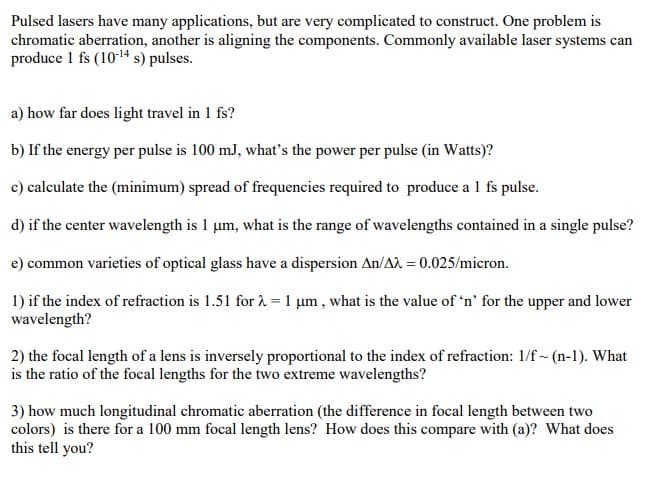Pulsed lasers have many applications, but are very complicated to construct. One problem is chromatic aberration, another is aligning the components. Commonly available laser systems can produce 1 fs (10-¹4 s) pulses. a) how far does light travel in 1 fs? b) If the energy per pulse is 100 mJ, what's the power per pulse (in Watts)? c) calculate the (minimum) spread of frequencies required to produce a 1 fs pulse.
Pulsed lasers have many applications, but are very complicated to construct. One problem is chromatic aberration, another is aligning the components. Commonly available laser systems can produce 1 fs (10-¹4 s) pulses. a) how far does light travel in 1 fs? b) If the energy per pulse is 100 mJ, what's the power per pulse (in Watts)? c) calculate the (minimum) spread of frequencies required to produce a 1 fs pulse.
Related questions
Question
answer question fully please

Transcribed Image Text:Pulsed lasers have many applications, but are very complicated to construct. One problem is
chromatic aberration, another is aligning the components. Commonly available laser systems can
produce 1 fs (10-¹4 s) pulses.
a) how far does light travel in 1 fs?
b) If the energy per pulse is 100 mJ, what's the power per pulse (in Watts)?
c) calculate the (minimum) spread of frequencies required to produce a 1 fs pulse.
d) if the center wavelength is 1 um, what is the range of wavelengths contained in a single pulse?
e) common varieties of optical glass have a dispersion An/A2 = 0.025/micron.
1) if the index of refraction is 1.51 for λ = 1 um, what is the value of 'n' for the upper and lower
wavelength?
2) the focal length of a lens is inversely proportional to the index of refraction: 1/f~ (n-1). What
is the ratio of the focal lengths for the two extreme wavelengths?
3) how much longitudinal chromatic aberration (the difference in focal length between two
colors) is there for a 100 mm focal length lens? How does this compare with (a)? What does
this tell you?
Expert Solution
This question has been solved!
Explore an expertly crafted, step-by-step solution for a thorough understanding of key concepts.
Step by step
Solved in 3 steps
